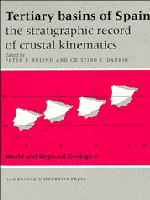Book contents
- Frontmatter
- Contents
- List of contributors
- Preface
- Dedication to Professor Oriol Riba IArderiu
- Memorial, Etienne Moissenet 1941–1994
- PART G GENERAL
- PART E EAST
- PART W WEST
- PART C CENTRE
- PART S SOUTH
- S1 The Betic Neogene basins: introduction
- S2 Neogene palaeogeography of the Betic Cordillera: an attempt at reconstruction
- S3 Depositional model of the Guadalquivir – Gulf of Cadiz Tertiary basin
- S4 Late Neogene depositional sequences in the foreland basin of Guadalquivir (SW Spain)
- S5 Miocene basins of the eastern Prebetic Zone: some tectono sedimentary aspects
- S6 Stratigraphic architecture of the Neogene basins in the central sector of the Betic Cordillera (Spain): tectonic control and base-level changes
- S7 Pliocene–Pleistocene continental infilling of the Granada and Guadix basins (Betic Cordillera, Spain): the influence of allocyclic and autocyclic processes on the resultant stratigraphic organization
- S8 Late Neogene basins evolving in the Eastern Betic transcurrent fault zone: an illustrated review
- S9 Tectonic signals in the Messinian stratigraphy of the Sorbas basin (Almeria, SE Spaín)
- S10 Basinwide interpretation of seismic data in the Alborán Sea
- Index
S2 - Neogene palaeogeography of the Betic Cordillera: an attempt at reconstruction
Published online by Cambridge University Press: 04 August 2010
- Frontmatter
- Contents
- List of contributors
- Preface
- Dedication to Professor Oriol Riba IArderiu
- Memorial, Etienne Moissenet 1941–1994
- PART G GENERAL
- PART E EAST
- PART W WEST
- PART C CENTRE
- PART S SOUTH
- S1 The Betic Neogene basins: introduction
- S2 Neogene palaeogeography of the Betic Cordillera: an attempt at reconstruction
- S3 Depositional model of the Guadalquivir – Gulf of Cadiz Tertiary basin
- S4 Late Neogene depositional sequences in the foreland basin of Guadalquivir (SW Spain)
- S5 Miocene basins of the eastern Prebetic Zone: some tectono sedimentary aspects
- S6 Stratigraphic architecture of the Neogene basins in the central sector of the Betic Cordillera (Spain): tectonic control and base-level changes
- S7 Pliocene–Pleistocene continental infilling of the Granada and Guadix basins (Betic Cordillera, Spain): the influence of allocyclic and autocyclic processes on the resultant stratigraphic organization
- S8 Late Neogene basins evolving in the Eastern Betic transcurrent fault zone: an illustrated review
- S9 Tectonic signals in the Messinian stratigraphy of the Sorbas basin (Almeria, SE Spaín)
- S10 Basinwide interpretation of seismic data in the Alborán Sea
- Index
Summary
Abstract
The Neogene palaeogeography of the Betic Cordillera is reviewed in the context of the following western Mediterranean events: the initial opening of the Algerian basin and the Alboran Sea, the progressive westward displacement and continuous stretching of the Betic-Rifian Internal Zone, the collision with the External Zones and formation of the North-Betic Strait, the destruction of the Flysch Basin and the beginning of the formation of the Gibraltar Arc. Depending on the particular event, this complex sequence began between the Early Aquitanian (or Late Oligocene?) and the end of the Early Burdigalian and continued with lesser intensity during the Middle Miocene, becoming practically paralysed in the Late Miocene. Then, the Prebetic zone was particularly deformed and emerged, the North-Betic Strait closed and considerable uplift of the entire Cordillera began. These last events, together with those taking place in the Rif and the eustatic lowering, brought about the Messinian salinity crisis in the Mediterranean. By this last time there was already a clear distinction between the Atlantic and Mediterranean basins in the Betic Cordillera. The situation in the Pliocene and more especially in the Quaternary was very similar to the present.
Introduction: regional setting of the Betic Cordillera
In the present chapter we present an interpretation of the Neogene palaeogeography of the Betic Cordillera in the context of the western Mediterranean.
- Type
- Chapter
- Information
- Tertiary Basins of SpainThe Stratigraphic Record of Crustal Kinematics, pp. 323 - 329Publisher: Cambridge University PressPrint publication year: 1996
- 8
- Cited by



